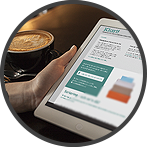Concrete meetings and high speed notes
Datum: 2010-02-04 10:47

In a normal week at work, I have got a lot of different meetings with different people. It can be project-meetings, sales-meetings, lunch meetings or other kinds of meetings.
It is important for me that all of my meetings result in some form of progression, that they are tangible, and that all parties know the purpose of the meeting. It is not necessary that we make decisions in every meeting for things to progress; some meetings’ primary purpose is to get to know each other and our respective businesses, but in these cases it’s still important for me to determine what the next step is.
What’s the next step?
When I’ve got so many meetings, I risk forgetting what we were talking about and what the next step was if I don’t make a few brief notes right after the meeting and write them down as tasks in my to-do-list (or ”waiting for”-list).
But, since my time is short as well, and the processing of and supplementary work on the notes can’t be time-consuming, I have created a standard template for taking meeting notes that I usually use. It is quite simply a blank sheet of paper with some pre-printed fields on it.
In the header
In the top left corner I write what project, what client, or what idea the meeting concerns. At the top and center of the page, as a headline, I write down what kind of meeting it is, for example ”Meeting on…”. Finally, I write down the participants of the meeting in the top right corner.
First, reasoning
Viewed roughly, almost all my meetings consist of two parts. First, a conversation where we discuss the subject. One of us may present an idea or proposal which he wants the others to have an opinion on. At another occasion I may present the status of the ongoing project and what threats and possibilities I think lie ahead. On the upper half of the template I write short notes about this discussion. Sometimes it’s detailed, other times it’s only brief notes.
Sometimes, decisions
Now and then during the meeting it is possible that decisions are made. If so, I write down the decision made clearly in one of three pre-printed decision-boxes on the lower part of the paper. If it’s a project meeting, I’ll write down the decisions again in a separate document, where I keep all made decisions. That document will serve as a set of rules that the project has to subject to.
Always, the next step
Towards the end of the meeting, and sometimes even during the discussion, we define the next step, which can turn out to be several steps. For me, the next step consists of a to-do-task, someone responsible for the task and often also a deadline. At the bottom of the template I’ve pre-printed three fields were I can write down the next steps.
Afterwards, back at the office
So, when the meeting is over, my priority is to write down the next steps as tasks in the to-do-list. This is the most important part. If I’ve got time and if the notes are essential, I also write down the notes in the running document for the project or the client. I often use what is called a wiki, which you can search through and edit easily.
Quick and efficient processing of the notes
The benefits with working with a template for taking meeting-notes has for me been the ability to quickly take care of the notes and the to-do-tasks after the meeting, which is possible since they are already defined clearly from the spontaneous notes made in the meeting.
I don’t have to skim through my notes searching for things that have to be done. All I need to do is to look at the bottom of the notes and be rest assured that all the important information is there.
Making the processing of meeting notes so quick and efficient results in that no notes are left lagging behind unprocessed and I no longer risk missing any commitments due to not having put them on my to-do-list when I should have.
What’s the structure of your meetings?
If you want to, take a minute to think of how your meetings tend to be laid out, roughly speaking. In a standard format for your note taking, what sections, fields or boxes would you need? I am sure you have other tricks to easily and efficiently handle the result of a meeting, and I am curious to hear what they are.
Feel free to leave a comment below.




